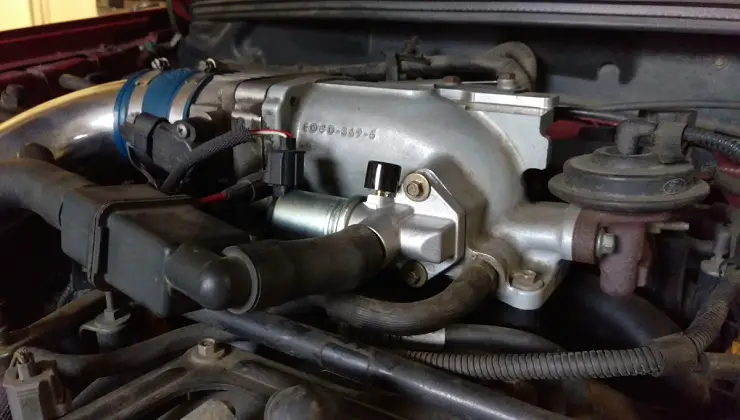If you’re a proud owner of a Mustang, you know that this car is a symbol of power and performance. However, as with any car, Mustangs can experience mechanical problems, and one of the most common issues is related to the idle air control valve.
In this article, we will discuss the symptoms of mustang idle air control valve problems and provide a step-by-step guide on how to fix them.
Contents
- 1 What is an idle air control valve (IAC valve)?
- 2 Common Mustang Idle Air Control Valve Problems
- 3 Causes of Mustang Idle Air Control Valve Problems
- 4 Solutions to Mustang Idle Air Control Valve Problems
- 5 Preventing Mustang Idle Air Control Valve Problems
- 6 Frequently Asked Questions (FAQs)
- 7 Conclusion
What is an idle air control valve (IAC valve)?
Before we dive into the problems associated with the idle air control valve, let’s briefly discuss what it is and what it does. The IAC valve is a component of your vehicle’s engine management system that regulates the amount of air that enters the engine when the throttle is closed. It does this by adjusting the size of a bypass passage that allows air to bypass the throttle plate.
The IAC valve ensures that the engine runs smoothly at idle by adjusting the amount of air that enters the engine to compensate for changes in load.
Common Mustang Idle Air Control Valve Problems
We have listed some common problems. These are –
- Rough or Erratic Idle: A rough or erratic idle is one of the most common symptoms of a failing IAC valve. You may notice that your Mustang is idling rough or stalling when you come to a stop. This is because the IAC valve is not regulating the amount of air that enters the engine properly.
- High or Low Idle Speed: A malfunctioning IAC valve can cause the idle speed to be too high or too low. If the idle speed is too high, the engine will be running at a faster pace than it should be, which can lead to engine damage over time. If the idle speed is too low, the engine may stall when you come to a stop.
- Engine Misfires: If the IAC valve is not functioning correctly, the engine may misfire. This can cause a loss of power and poor fuel economy. If left unchecked, it can also lead to engine damage over time.
- Check Engine Light: A malfunctioning IAC valve can trigger the check engine light on your Mustang’s dashboard. The engine control module will detect that the IAC valve is not functioning correctly and will set a code to indicate the problem.
Causes of Mustang Idle Air Control Valve Problems
There are several factors that can contribute to idle air control valve problems in your Mustang. Some of the most common causes include:
- Carbon Buildup: Carbon buildup in the IAC valve can cause it to stick in the closed position, preventing it from regulating the amount of air that enters the engine properly. This can cause a rough or erratic idle.
- Electrical Issues: If there is an issue with the wiring or electrical connections to the IAC valve, it may not function correctly. This can cause a range of symptoms, including a rough or erratic idle, high or low idle speed, engine misfires, and more.
- Vacuum Leaks: A vacuum leak in the intake system can cause the IAC valve to malfunction. This is because the IAC valve relies on vacuum pressure to function properly. If there is a leak in the system, the IAC valve may not receive the vacuum pressure it needs to regulate the amount of air that enters the engine.
- Dirty Air Filter: A dirty air filter can restrict the airflow to the engine, which can cause the IAC valve to malfunction.
Solutions to Mustang Idle Air Control Valve Problems
If you’re experiencing idle air control valve problems in your Mustang, there are a few things you can do to solve the issue. Some possible solutions include:
- Cleaning the IAC Valve: If carbon buildup is causing the IAC valve to malfunction, you may be able to clean it with a specialized cleaning solution. This can often be done by removing the valve from the engine and spraying it with the cleaner. This can help to remove any buildup that may be causing the valve to stick.
- Replacing the IAC Valve: If cleaning the IAC valve doesn’t solve the problem, you may need to replace it altogether. This is often the case if the valve is damaged or has become worn over time. It’s important to choose a high-quality replacement part to ensure that your Mustang runs smoothly.
- Checking for Vacuum Leaks: If a vacuum leak is causing the IAC valve to malfunction, you will need to locate and repair the leak. This may involve replacing a cracked or damaged hose, gasket, or other components of the intake system.
- Checking Electrical Connections: If there is an issue with the wiring or electrical connections to the IAC valve, you will need to diagnose and repair the problem. This may involve checking the wiring for damage or corrosion, replacing a faulty connector, or replacing the valve altogether if it’s been damaged due to an electrical issue.
Preventing Mustang Idle Air Control Valve Problems
While it’s not always possible to prevent idle air control valve problems in your Mustang, there are a few things you can do to reduce the risk of issues occurring. Some preventive measures include:
- Regular Maintenance: Performing regular maintenance on your Mustang can help to ensure that all components are functioning correctly. This can include things like oil changes, air filter replacements, and tune-ups.
- Driving Habits: The way you drive can have an impact on the health of your Mustang’s engine. Avoid driving aggressively and try to accelerate and decelerate smoothly to reduce wear and tear on the engine.
- Quality Parts: Choosing high-quality parts when performing repairs or maintenance can help to ensure that your Mustang runs smoothly and reliably. This includes components like the idle air control valve.
Frequently Asked Questions (FAQs)
Q: Can I replace the IACV in my Mustang myself?
A: If you have some experience with car repairs and the necessary tools, you may be able to replace the IACV in your Mustang yourself. However, if you’re not confident in your ability to do so, it’s best to have a qualified mechanic or technician handle the repair to avoid causing further damage to your vehicle.
Q: How much does it cost to replace an IACV in a Mustang?
A: The cost of replacing an IACV in a Mustang can vary depending on the make and model of the car, as well as the location of the repair shop. The cost of the replacement part itself is typically between $50 and $200, and labor costs can range from $50 to $150 or more, depending on the complexity of the repair.
Q: How long does it take to replace an IACV in a Mustang?
A: The time it takes to replace an IACV in a Mustang can vary depending on the make and model of the car, as well as the location of the repair shop. In most cases, the replacement process can be completed within a few hours, though more complex repairs may take longer.
Q: Are IACV problems common in Mustangs?
A: IACV problems are not uncommon in Mustangs, particularly in older models. However, regular maintenance and proper care can help prevent these types of problems from developing.
Q: Is it safe to drive a Mustang with a faulty IACV?
A: It is generally not recommended to drive a Mustang with a faulty IACV, as the problem can cause the engine to run poorly, stall, or even fail completely. If you notice any symptoms of an IACV problem, it’s important to have it diagnosed and repaired as soon as possible to avoid further damage to your vehicle.
Conclusion
The idle air control valve is a crucial component of your Mustang’s engine management system. If it’s not functioning correctly, it can lead to a range of problems, including rough or erratic idle, high or low idle speed, engine misfires, and more.
By understanding the causes of idle air control valve problems and the solutions available, you can keep your Mustang running smoothly and avoid costly repairs down the line.
Remember, if you’re not comfortable performing these repairs yourself, it’s always best to seek the help of a professional mechanic.




